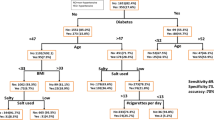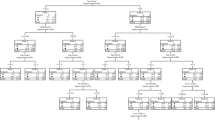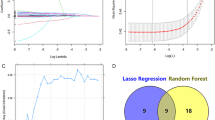Abstract
Most current statistical strategies for determining risk factors for hypertension (HT) among certain populations have proved inconclusive. In this study, the classification tree method, which is more practical and easy to understand than other statistical methods, was used to determine the risk for HT among outpatients in a clinic in Denizli province, western Turkey, between January 2002 and July 2004. The effects of 14 risk factors (body mass index, waist-to-hip ratio, age, serum total cholesterol, serum triglycerides, sex, HT in first-degree relatives, diabetes mellitus, smoking, stress factors, alcohol consumption, dyslipidemia in first-degree relatives, dyslipidemia [previously diagnosed], and saturated fat consumption) on HT were evaluated in this population. In all, 1761 adults at the outpatient clinic were recruited for lipid and HT measurements. The classification tree method revealed 7 main risk factors (body mass index, waist-to-hip ratio, sex, serum triglycerides, serum total cholesterol, HT in first-degree relatives, and saturated fat consumption) for HT. The findings of the present study suggest that the classification tree is a valuable statistical method for evaluating multiple risk factors for HT.
Similar content being viewed by others
References
Bonaa KH, Thelle DS. Association between blood pressure and serum lipids in a population: the Tromso Study.Circulation. 1991; 83: 1305–1314.
Selby JV, Friedman GD, Quesenberry CP Jr. Precursors of essential hypertension: pulmonary function, heart rate, uric acid, serum cholesterol, and other serum chemistries.Am J Epidemiol. 1990; 131: 1017–1027.
Tozawa M, Oshiro S, Iseki C, et al. Multiple risk factor clustering of hypertension in a screened cohort.J Hypertens. 2000; 18: 1379–1385.
Harper PR, Sayyad MG, deSenna V, Shahani AK, Yajnik CS, Shelgikar KM. A systems modelling approach for the prevention and treatment of diabetic retinopathy.Eur J Oper Res. 2003; 150: 81–91.
Camdeviren H, Mendes M, Özkan MM, Toros F, Sasmaz T, Öner S. Determination of depression risk factors in children and adolescents by using regression tree methodology.Acta Med Okayama. 2005; 59: 19–26.
Abu-Hanna A, de Keizer N. Integrating classification trees with local logistic regression in intensive care prognosis.Artif Intell Med. 2003; 29: 5–23.
Breiman L, Friedman JH, Olshen RA, Stone CJ.Classification and Regression Trees. Belmont, Calif: Wadsworth; 1984: 358.
Fu CY. Combining loglinear model with classification and regression tree (CART): an application to birth data.Comp Stat Data Anal. 2004; 45: 865–874.
Robnik-Sikonja M, Cukjati D, Kononenko I. Comprehensible evaluation of prognostic factors and prediction of wound healing.Artif Intell Med. 2003; 29: 25–38.
Kannel WB, Brand N, Skinner JJ Jr, Dawber TR, McNamara PM. The relation of adiposity to blood pressure and development of hypertension. The Framingham study.Ann Intern Med. 1967; 67: 48–59.
Haffner SM, Ferrannini E, Hazuda HP, Stern MP. Clustering of cardiovascular risk factors in confirmed prehypertensive individuals.Hypertension. 1992; 20: 38–45.
Stamler R, Stamler J, Riedlinger WF, Algera G, Roberts RH. Family history and prevalence of hypertension: results of a nationwide screening program.JAMA. 1979; 241: 43–46.
Lean EMJ, Han TS, Seidell JC. Impairment of health and quality of life in people with large waist circumference.Lancet. 1998; 351: 853–856.
Landsberg L. Diet, obesity and hypertension: a hypothesis involving insulin, the sympathetic nervous system, and adaptive thermogenesis.Q J Med. 1986; 61: 1081–1090.
Perin PC, Maule S, Quadri R. Sympathetic nervous system, diabetes, and hypertension.Clin Exp Hypertens. 2001; 23: 45–55.
Agha H, Dillon D, Corbett M, Sreenan S. Target blood pressure for patients with type 2 diabetes is difficult to achieve in the setting of a busy diabetes clinic.Irish J Med Sci. 2003; 172: 168–170.
Wilson PW, D’Agostino RB, Levy D, Belanger AM, Silbershatz H, Kannel WB. Prediction of coronary heart disease using risk factor categories.Circulation. 1998; 97: 1837–1847.
The Lipid Research Clinics Coronary Primary Prevention Trial results. II. The relationship of reduction in incidence of coronary heart disease to cholesterol lowering.JAMA. 1984;251:365–374.
Gueyffier F, Boissel JP, Pocock S, et al. Identification of risk factors in hypertensive patients: contribution of randomized controlled trials through an individual patient database.Circulation. 1999; 100: 88–94.
Glazer NL, Smith NL, Heckbert SR, Doggen CJM, Lemaitre RN, Pasty BM. Risk of myocardial infarction attributable to elevated levels of total cholesterol among hypertensives.Am J Hypertens. 2005; 18: 759–766.
Bell AC, Adair LS, Popkin BM. Ethnic differences in the association between body mass index and hypertension.Am J Epidemiol. 2002; 155: 346–353.
Deurenberg P, Yap M, van Staveren WA. Body mass index and percent body fat: a meta analysis among different ethnic groups.Int J Obes Metab Disord. 1998; 22: 1164–1171.
Adair LS. Dramatic rise in overweight and obesity in adult Filipino women and risk of hypertension.Obes Res. 2004; 12: 1335–1341.
Carneiro G, Faria AN, Ribeiro Filho FF, et al. Influence of body fat distribution on the prevalence of arterial hypertension and other cardiovascular risk factors in obese patients [in Portuguese].Rev Assoc Med Bras. 2003; 49: 306–311.
Buntine WL. Learning classification trees.Statist Comput. 1992; 2: 63–73.
Kerby DS. CART analysis with unit-weighted regression to predict suicidal ideation from big five traits.Pers Ind Diff. 2003; 35: 249–261.
Siciliano R, Mola F. Multivariate data analysis and modelling through classification and regression trees.Comput Statist Data Anal. 2000; 32: 285–301.
Terin N, Schmid CH, Griffith JL, D’Agostino RB, Sekler HP. External validity of predictive models: a comparison of logistic regression, classification trees and neural networks.J Clin Epidemiol. 2003; 56: 721–729.
Author information
Authors and Affiliations
Rights and permissions
About this article
Cite this article
Akdag, B., Fenkci, S., Degirmencioglu, S. et al. Determination of risk factors for hypertension through the classification tree method. Adv Therapy 23, 885–892 (2006). https://doi.org/10.1007/BF02850210
Issue Date:
DOI: https://doi.org/10.1007/BF02850210




